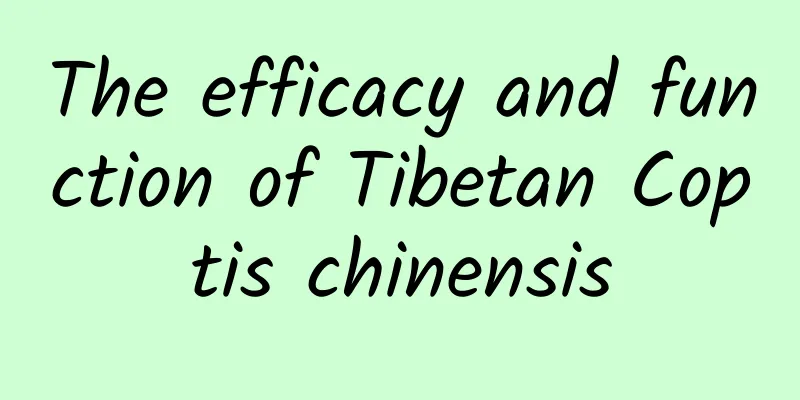The efficacy and function of Tibetan Coptis chinensis

|
As people's research on traditional Chinese medicine deepens, they gradually understand the detailed ingredients in various traditional Chinese medicines and the impact of these ingredients on everyone's health. Below I would like to recommend a traditional Chinese medicine, Tibetan Coptis chinensis, to you and describe the effects of Tibetan Coptis chinensis in detail. I hope it will be helpful to your study and research. [Source] Medicinal material source: The rhizome and root of Thalictrum stenophyllum of the Ranunculaceae family. [Original morphology] Narrow-ordered thrush, herbaceous plant in many places, 40-80cm tall. The whole plant is hairless. The stem is erect and branched at the top. Leaves are alternate; petioles are about 12cm long, with narrow sheaths at the base; intercalated leaves are membranous; leaves are three to four times trifoliate; blades are about 15cm long; leaflets are herbaceous, cuneate-shaped, obovate, broadly rhombic or nearly circular, 0.8-2.2cm long, 0.8-3cm wide, with rounded or obtuse apex, broadly cuneate, circular or shallowly cordate base, 3 shallowly or deeply fissured, with coarse teeth on the margins, nearly flat veins on both sides, and unclear reticulate veins. Inflorescence is racemose with slightly dense flowers; flowers are bisexual, with pedicels 1-2mm long; sepals 4, petal-shaped, elliptic, 2.5-3.5mm long, 1-1.5mm wide, white or yellowish green, caducous early; petals absent; stamens 7-10, about 4mm long, filaments narrower than anthers at the top, filamentous at the bottom, anthers elliptic, about 0.7mm long, with a short tip at the apex; carpels 4-8, styles long, fisted, stigma born on the ventral side. Achenes are flat ovoid, about 2.5mm long, with 6-10 longitudinal ribs, sessile or with a short stalk, persistent style 1-2mm long, fist-shaped. The flowering period is June-July, and the fruiting period is August-September. [Habitat distribution] Ecological environment: Growing on mountain grass slopes, forest edges or sparse woods at an altitude of 2300-3600m. [Chemical composition] The rhizome contains hernandezine, cryptopine, coptisoine, isotetrandrine, berberine, magnoflorine and jatrorrhizine. 【Nature and flavor】 Bitter; cold 【Meridian】 Liver; Heart; Large Intestine 【Functions and indications】 Clears away heat and detoxifies; cools the liver; stops dysentery. Mainly used for sores, carbuncle, swelling and poison; damp-heat jaundice; dysentery; conjunctivitis [Usage and Dosage] For oral use: decoction, 6-10g. For external use: take appropriate amount of fresh product, mash it and apply it on the affected area. 【Excerpt】 Chinese Materia Medica The effects and functions of Tibetan Water Coptis chinensis have been described in detail above, and I believe everyone has a certain understanding of it. However, whether Tibetan Water Coptis chinensis has other therapeutic effects still requires further research. |
<<: The efficacy and function of Tibetan peach leaf coral root
>>: The efficacy and function of star-shaped Saussurea
Recommend
The efficacy and function of blue calyx fragrant tea
Although Western medicine and Western drugs are m...
What are the medicinal values of castor seeds?
Castor seeds are a kind of herb produced in the s...
The efficacy and function of long-spur orchid
The Chinese medicinal herb, Cymbidium, is a very ...
He made a fool of himself that year, but went on to dominate 40 years of postwar science
Richard Feynman (1918-1988). Image source: Wikipe...
What are the effects of Bai Fuling
White Poria cocos is relatively unfamiliar to peo...
The efficacy and function of Haihaicai
Traditional Chinese medicine often has unexpected...
The efficacy and function of Acer palmatum
Acer truncatum is a very common and frequently us...
Effects of Astragalus and Plum
Scutellaria baicalensis itself is a relatively mo...
The third AIDS patient was "cured"! Can humans finally conquer AIDS?
On February 15, American researchers reported the...
How can I tell the authenticity of the wine I bought for my dad?
Image source: Tuchong Creative How can I tell the...
What is Tongkat Ali?
Tongkat Ali is actually an evergreen tree that gr...
The efficacy and function of Pear
As people's research on traditional Chinese m...
The efficacy and function of gold ore
The environment is now seriously deteriorating an...
How long to stew deer antlers
Deer antler has a good health care effect on the ...
The video of "katydid spinning silk and weaving a web" has gone viral! But it's not actually a katydid, it's also related to Ultraman...
There is a video that has gone viral online recen...









